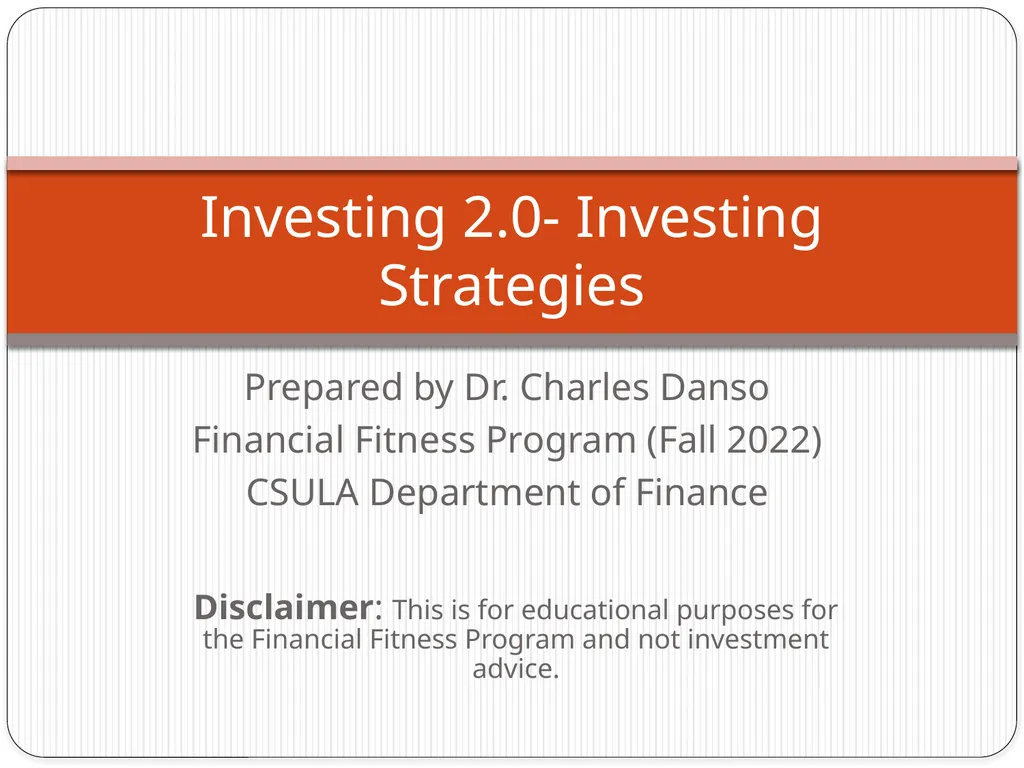Prepared by Dr. Charles Danso Financial Fitness
Author : tawny-fly | Published Date : 2025-05-14
Description: Prepared by Dr Charles Danso Financial Fitness Program Fall 2022 CSULA Department of Finance Investing 20 Investing Strategies Disclaimer This is for educational purposes for the Financial Fitness Program and not investment advice
Presentation Embed Code
Download Presentation
Download
Presentation The PPT/PDF document
"Prepared by Dr. Charles Danso Financial Fitness" is the property of its rightful owner.
Permission is granted to download and print the materials on this website for personal, non-commercial use only,
and to display it on your personal computer provided you do not modify the materials and that you retain all
copyright notices contained in the materials. By downloading content from our website, you accept the terms of
this agreement.
Transcript:Prepared by Dr. Charles Danso Financial Fitness:
Prepared by Dr. Charles Danso Financial Fitness Program (Fall 2022) CSULA Department of Finance Investing 2.0- Investing Strategies Disclaimer: This is for educational purposes for the Financial Fitness Program and not investment advice. What Is Your Reason for Investing Retirement Purchase Goal Job Income Replacement Income supplement Target purchases Savings (education goals, health accounts) Investing out of DESPERATION is not advisable. 2 Types of Investing 3 Speculation: Hoping to profit investing in something but also expecting a probability and possibility of loss Hedging: To create certainty in investment outcome by taking an opposite position to offset losses Arbitrage: Taking advantage of market mispricing or imperfections to make profit Involves simultaneously buying and selling the same asset in mispriced markets (for example) NOTE: These are also the main motivation of investors you can find in a market as well as categorizations. What is your risk Tolerance level 4 Definition Risk Tolerance: Level of risk an investor is willing to take on vs. Risk Capacity: How much loss one can comfortably manage given present circumstances PASS Allocation Score by William Droms & Steven Strauss More commonly used by practitioners and advisors Using Questionnaires Some investment platforms already have some (read disclaimers) https://www.investright.org/informed-investing/know-yourself/test-your-risk-tolerance/ https://pfp.missouri.edu/research/investment-risk-tolerance-assessment/ Risk Pyramid In Investing 5 NOTE: There is potential to lose money in investing. Losses can be substantial. There is also no guarantee of gains or profits. Psychology of Investing 6 Role of emotions Fear Greed Desperation Behavioral Biases in investing (some) include: Overconfidence bias Familiarity bias Loss aversion Self-attribution bias, etc. Types of Assets Discussed 7 Stocks Bonds Derivatives Options Futures Forwards Swaps Alternative Investments Traditionally applied to investments outside of stocks & bonds Art, Jewelry, vintage, collector’s items, antiques, etc. Real Estate Investment Theories (for most assets) Fundamental Analysis Assume that a stock’s intrinsic or real value is determined by the company’s future earnings Fundamental analyses consider things such as: Expected earnings, Financial strength of the company, Type of industry company is in, New product development, Economic growth of the overall economy. Technical Analysis Based on the assumption that a stock’s market value is determined by the forces of supply and demand in the stock market as a whole Deviates from fundamentalism by assuming that past market trends can predict the future direction for the market as a whole instead of fundamental value. Chartists plot past price movements and other market averages to observe trends they use














